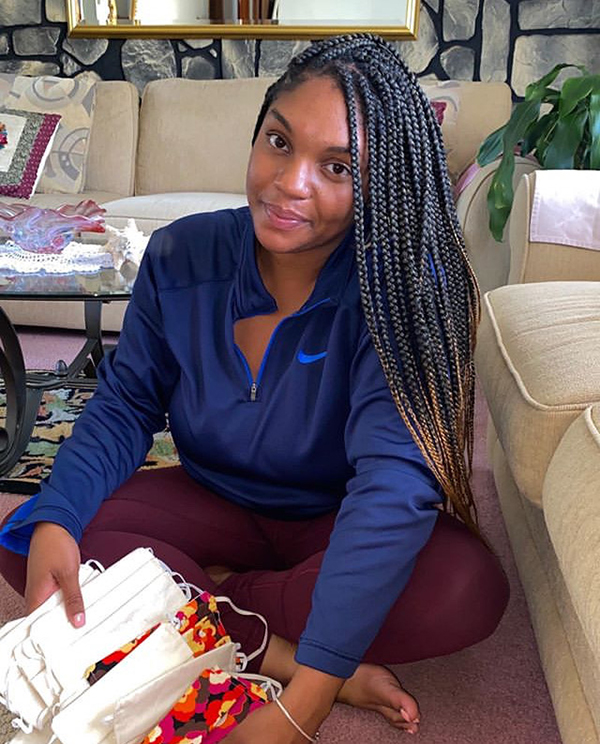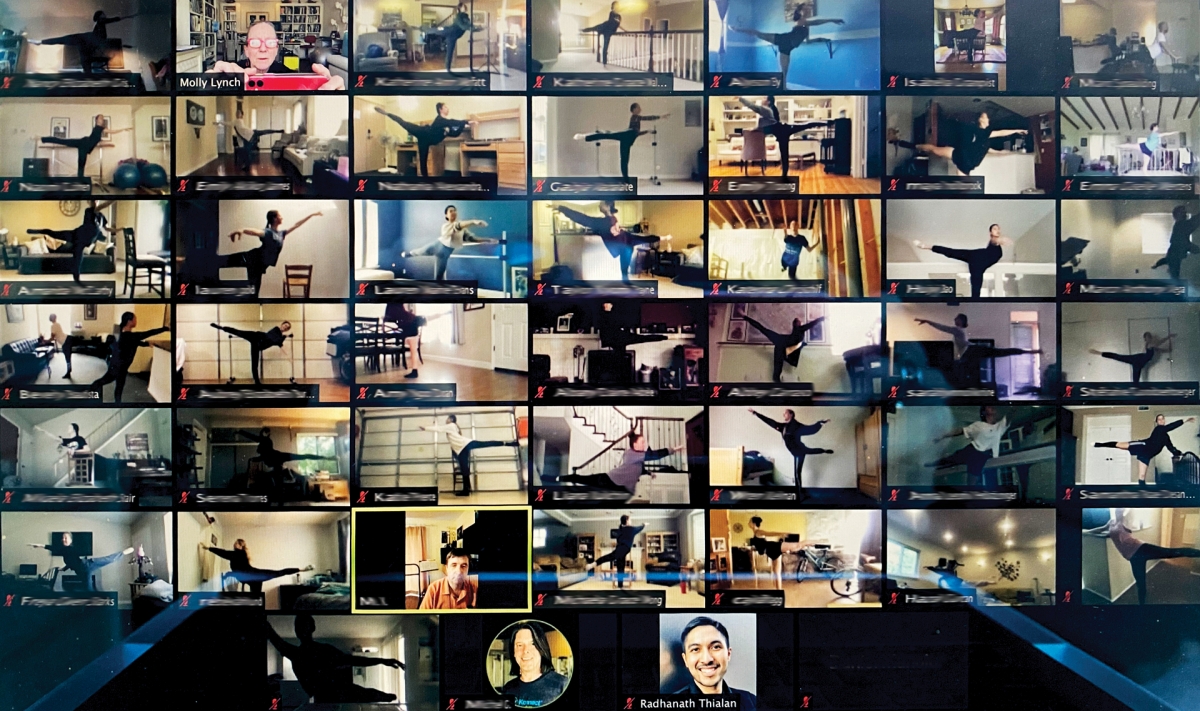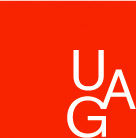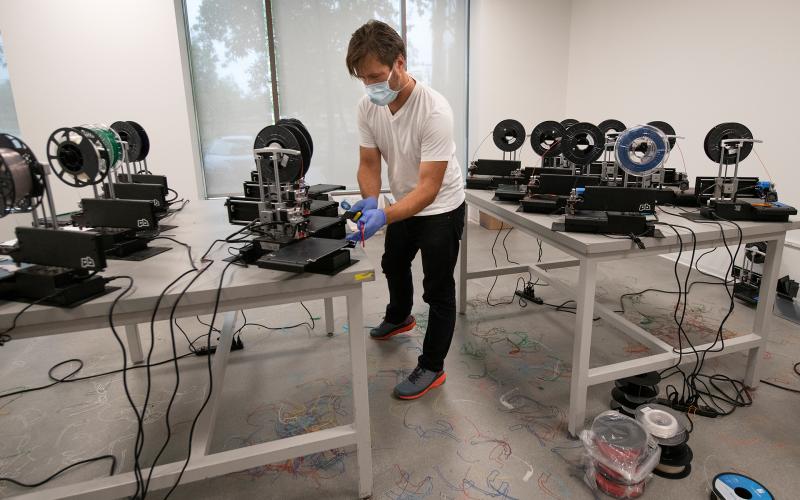Arts and Wellness
By Christine Byrd
The seats were empty, the orchestra silent, the studios dark.
More than 700 undergraduate and 150 graduate students, and the scores of faculty and staff who teach and support them, disappeared literally overnight. It was March 17, and the Claire Trevor School of the Arts, like the rest of the UCI campus, was completely closed down in response to the coronavirus pandemic gripping the globe.
Home and alone, it would be easy to let despair set in. How can art be taught remotely? Would arts be frivolous in the face of a deadly pandemic?
But with just a week to figure out logistics, the Spring Quarter began with every single one of CTSA’s planned art classes moving forward in newly online and remote formats.
Doorknobs became ballet barres, living rooms became stages, costume designers became mask makers, and creative inspiration was discovered in the most mundane daily routines.
“We were determined not just to hunker down, but to come out of this limitation having learned more things to do, better ways to interact,” says Stephen Barker, dean of the Claire Trevor School of the Arts. “This pandemic would be a stimulus to find new connections.”
Finding Purpose
Early in the shutdown, a call came into the main campus requesting help filling critical shortages of personal protective equipment (PPE) for healthcare workers at the UCI Medical Center. Jesse Colin Jackson, associate professor of art and associate dean of research and innovation, jumped into action. He packed up the 24 3D printers from his Speculative Prototyping Lab in the art department and moved them to the UCI Beall Applied Innovation building, where he collaborated with staff from the Samueli School of Engineering and Applied Innovation to design and produce face shields.
“In a crisis like this, it’s natural to focus on the promise of expensive scientific tools and equipment. But sometimes we have to move quickly with what we already have. Artists are society’s makers. Making things, and making them as well as I can with the materials I have on hand, is part of my skill set.”
Jackson and the team sped up manufacturing by using both laser cutters and 3D printers. Then, after the first 10,000 shields, they migrated to a more industrial process, utilizing a factory in north Orange County to die-cut rolled plastic into screens, and getting injection-molded frames made in Minnesota.
Ultimately, the effort provided 20,000 face shields to local healthcare workers, and reinvigorated Jackson’s own sense of purpose.
“Being stuck at home is hard,” he says. “It was a privilege to go to work every day and be one of thousands of people trying to be helpful.”
With the urgent need for PPE met and the project now complete, Jackson turned his attention to using thousands of colorful plastic scraps left over from the shields to create a new work of art, which will be permanently installed at Applied Innovation this fall.
Meanwhile, CTSA’s costume designers, who typically handle 1,000 costumes each year, had no performers to dress. So they started perfecting face mask patterns and sewing them by the dozen.
 “Pumping out a bunch of masks to help out our community ended up being the main focus of our quarter,” says Cassie DeFile, a second-year M.F.A. student in costume design. She and her colleagues started sewing masks at home, with materials provided by CTSA.
“Pumping out a bunch of masks to help out our community ended up being the main focus of our quarter,” says Cassie DeFile, a second-year M.F.A. student in costume design. She and her colleagues started sewing masks at home, with materials provided by CTSA.
“It really made us feel good because we had a purpose when a show wasn’t going on, but also because we knew the items we were making were going to people who needed them.”
By midsummer, more than 700 face masks had been sewn and donated not only to local nonprofits, but to the Navajo Nation, hospitals in New Mexico and nursing homes in Washington that expressed need.
Surprisingly, even though they were farther apart geographically, the pandemic strengthened students’ connections.
“I’ve grown closer to my peers because of this,” says Sarah Monaghan Fulford, a second-year M.F.A. in costume design currently staying in Washington, who sewed more than 200 masks using quilting scraps from her 70-year-old mother. “We talk so much more now, and we have to take time to communicate with each other, so the amount that we talk and the quality of what we talk about is more present.”
Photo: Chantrell Lewis, an M.F.A. student, started sewing masks at home with materials provided by CTSA. (Corrected from a previous version of this story.)
Streaming Art
While the pandemic created everyday challenges, it also introduced potentially game-changing opportunities for how the arts school collaborates with other facets of the university and the community at large.
In the spring, every department showcased student work online, from dance’s Physical Graffiti Online to music’s UCI Opera Salon. Although performers missed their in-person audiences, the online format allowed far-flung family and friends to see the student artists in action.
“People can see our students perform online in the comfort of their own home, and at any time that it’s convenient,” says Don Hill, chair of the drama department.
Back when the drama department was planning its 2020-21 season, Hill decided to participate in the nationwide Jubilee year, an effort to share more underrepresented voices in theaters.
“The hope is that for students who are struggling with a zillion issues, from gender identification, to food insecurity or worrying about how to get out of a dysfunctional relationship, that they will find something they can connect with in this very eclectic season,” says Hill. “We want the audience to relate to these characters as themselves, or as someone they know, and to understand how they are feeling, because really drama is about shared human experiences.”
Throughout the Jubilee year, Hill plans to build on the lessons and successes of the spring by streaming prerecorded performances, as well as hosting live, interactive online events with the shows’ artistic teams. Ultimately, the pandemic may expand CTSA’s offerings to a larger audience than anyone previously imagined.
“We will continue to take advantage of the tech expertise we’ve gained with online engagement,” says Barker. “So when we go back to live shows onsite, we will continue to have the options of electronic or computer connections through the web, giving CTSA a whole new ability to reach internationally.”
Arts and Wellbeing
Further proving the success of CTSA’s spring pivot online, summer school enrollment surged. One course offered online this summer, Scientific Concepts of Health, is a popular general education course offered in the dance department for science credit. The class attracts students from a wide variety of disciplines across campus, and introduces them to scientific research that shows human health is enhanced by both creating and engaging with art, from dancing to listening to music.
Studies around the globe have shown arts engagement can help impoverished families eat healthier foods, reduce anxiety and depression in postpartum mothers, improve children’s mood and self-esteem, and protect older individuals from dementia. In one study, elderly people who participated in activities such as painting, pottery, dance, music, poetry and drama made fewer doctor appointments and requested less medication.
Art might be part of the prescription for wellness in the time of COVID-19. In fact, Barker has declared 2020-21 the year of “Arts and Wellbeing,” with plans to focus attention on the ways art benefits physical, social and emotional wellbeing.
“Wellbeing means finding strategies to deal with the entire gamut of human experience, and that includes producing physical changes through the experience of arts that help diminish stress and promote coping skills,” says Barker.
“How do we have the coronavirus, an economic crisis, the murder of George Floyd, and all of this stuff coming at us, and for us as individuals to not get lost in it?” Barker asks. “Art is essential to dealing with that.”
At the beginning of 2020, the Beall Center for Art + Technology hosted “American Monument,” an interactive experience where guests played audio recordings of real-life police brutality and violence. Today, in the wake of the renewed Black Lives Matter movement, the choice seems prescient.
“‘American Monument’ was the perfect example of art confronting the worst that society has to offer, and the horror of what humans are capable of doing to each other,” says Barker. “Not everyone had the same reaction to the show, and not everyone’s opinion was changed by it, but it was impossible to leave without feeling a higher sense of awareness of one’s own emotional reaction to the material, and without feeling complicit in it.”
Experiencing art like this gives us the ability to respond to life’s challenges in more meaningful ways, Barker explains.
“Art helps us navigate the human experience in healthy ways, enhancing our wellbeing,” says Barker. “And art works to promote well-being not just at the individual level, it also operates at the larger social and cultural level.”

Photo: Studio courses in the four departments were presented via Zoom. Here, Professor Molly Lynch (second box on the top left) teaches a ballet course remotely. (Photo by Molly Lynch)
The Science of Health
Dr. Kelli Sharp works at the intersection of arts and health. As an assistant professor of dance as well as a doctor of physical therapy, her research explores both how dancers can best stay healthy and how movement therapy can benefit people with neurological disorders —such as people with PTSD or those who have experienced a stroke.
Sharp is one of several CTSA faculty involved with the UCI Center for Medical Humanities, which was created at UCI in 2018 to foster research into the arts, sciences, and our fundamental humanity.
“We are often siloed as either scientists or as artists,” says Sharp, who says she has felt this keenly in her own experience. “The Center for Medical Humanities provides a space for faculty to develop and cultivate projects that collaborate across these disciplines.”
Sharp, who teaches CTSA’s course on science of health, asked her online students this summer to engage in an artistic practice and measure their anxiety using a well-known Dimensions of Wellness framework. One student, a dancer, chose to paint images that reminded her of performing on stage pre-COVID. The mere act of painting measurably reduced her anxiety.
“The arts play a pivotal role encouraging wellness in various dimensions,” says Sharp. “We have to encourage the online platforms during the pandemic, whether they are for pure entertainment like Disney+, or participatory events like online painting that promote social wellness during this period of isolation. Art activates different areas of our brain that can help us feel connected and healthier.”
While the role of the arts in health and wellness becomes increasingly clear in academic research and in our everyday lives, the idea is not new. The Greek word for art, techne, is the root for technology and technique, reflecting the ancient belief that art is a useful — even essential — skilled craft.
“Increasingly my effort is to remind the people gaining their techne, technical expertise, in the Claire Trevor School of the Arts, that there’s a reason they are doing so at a top research institution,” says Barker. “The technical expertise they hone here contributes to our social, cultural and personal wellbeing.”
Learn more about programs, exhibitions, and initiatives surrounding arts and wellness at www.arts.uci.edu
Please visit our secure direct giving page and make a gift today!

